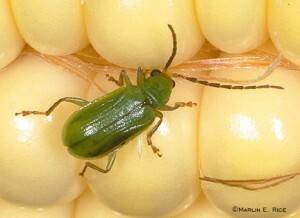With most of the 2013 crop in the ground, it’s time to walk fields. Crops should be scouted within 3 to 5 days of planting and then regularly throughout the growing season. Be on the lookout for: (1) crop emergence; (2) nitrate leaching and (3) insect and disease pressure
It’s a good idea to walk fields within 5 days of planting. Evaluating current stands can indicate whether to replant portions of the field. Notes you take now also could impact your seed buying decisions this fall. Plus, evaluating current stands can help determine if adjustments should be made to your equipment or planter speed next spring.
When checking fields where the corn is more developed, look for signs of nitrogen loss. Iowa State University Nutrient Management Specialist John Sawyer says the best options for sidedressing, in order from most to least preferable, include:
- injected anhydrous ammonia, UAN or urea,
- broadcast dry ammonium nitrate, ammonium sulfate or urease treated urea,
- surface dribbling UAN solution between rows,
- broadcast UAN, and
- broadcast urea.
 Also walk every field for signs of corn rootworm (CRW), regardless of what traits they planted. The corn rootworm hatch is underway, so larvae will soon begin feeding on roots if they aren’t already doing so. Corn development, although delayed, still provides plenty of plant material for the CRW larvae to feast upon. Severe infestation can destroy nodes 4-6, which effect water and nutrient uptake.
Also walk every field for signs of corn rootworm (CRW), regardless of what traits they planted. The corn rootworm hatch is underway, so larvae will soon begin feeding on roots if they aren’t already doing so. Corn development, although delayed, still provides plenty of plant material for the CRW larvae to feast upon. Severe infestation can destroy nodes 4-6, which effect water and nutrient uptake.
Because of the wide variance in planting dates this year, rootworm beetles can move between fields in search of the best “buffet.” A late maturing corn field may attract a large numbers of beetles if neighboring corn stopped producing pollen, for example. Beetles may also move into corn and/or soybean fields that have an abundance of pollen-producing weeds, including volunteer corn, ragweed or foxtails.
Weed control is important for several reasons. Crops have a better chance of reaching optimal yield when they’re not competing with weeds for sunlight, water and nutrients. Plus, controlling weeds helps control corn rootworm populations. The rootworm hatch is underway; expect 50 percent hatch between 684-767 degree days. Click here for current degree day accumulation for corn rootworm provided by the Iowa Environmental Mesonet, ISU Department of Agronomy.
